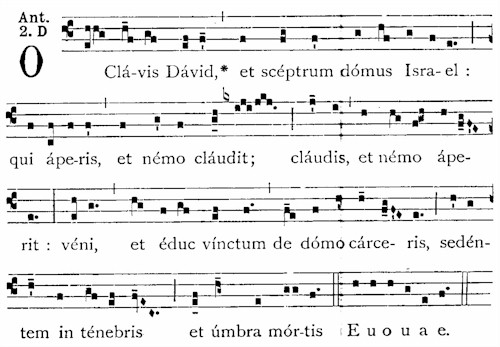 We continue our look at the O Antiphons with today’s O Clavis David
We continue our look at the O Antiphons with today’s O Clavis David
Again we hear the theme of Christ as the Liberator.
LATIN: O clavis David, et sceptrum domus Israel: qui aperis, et nemo claudit; claudis, et nemo aperit: veni, et educ vinctum de domo carceris, sedentem in tenebris.
ENGLISH: O Key of David, and scepter of the house of Israel, who opens and no man shuts, who shuts and no man opens: come, and bring forth the captive from his prison, he who sits in darkness and in the shadow of death.
Scripture Reference:
Isaiah 22:22
Revelation 3:7
Relevant verse of Veni, Veni Emmanuel:
O come, thou Key of David, come,
And open wide our heavenly home;
Make safe the way that leads on high,
And close the path to misery.
Do not fall into the trap of thinking that the we are dealing with events isolated solely in the past. Even taking just the image of the key in Scripture, we see how God’s plan is still in effect for us today, and we are all still players in his plan for salvation. The Old Testament reference from Isaiah helps us see this.
In Isaiah we read how the Lord said to Shebna, who was the master of the household of King Hezekiah:
“And it shall come to pass in that day, that I will call my servant Eliakim the son of Helkias, and I will clothe him with thy robe, and will strengthen him with thy girdle, and will give thy power into his hand: and he shall be as a father to the inhabitants of Jerusalem, and to the house of Juda. And I will lay the key of the house of David upon his shoulder: and he shall open, and none shall shut: and he shall shut and none shall open. And I will fasten him as a peg in a sure place, and he shall be for a throne of glory to the house of his father”.
God established in the House of David an office to be handed down through a succession, an office of jurisdiction. The vicar of the Davidic King would exercise the King’s authority.
This same language and image was used by our Lord when in Matthew 16 He conferred His own authority on Peter to exercise as a office to be handed down in a succession. The Lord, the David King Priest Messiah, gave His keys to Peter. His clear intent, clear from the David key image He used, was to establish an office with a succession.
In Revelation 3:7 the Lord is described as He who still wields David’s key. Even as Peter holds the keys on earth, it is the Lord’s own hand which holds Peter’s hand.
Truly the Lord who came to us at Bethlehem is with us always in His Church until His ultimate Coming at the end of the world. He is, in a real sense, the Key itself which Peter wields to open doors and to shut, to bind chains and to loose.
Let’s sing about the Key with the help of the terrific Benedictine monks of Le Barroux. NB: They don’t use the flat “ti”.


































1) Thank you, Father, for posting the notation and the sound file. Edifying. One choir I sing in will be using O Rex Gentium on Sunday, at the end of an afternoon Mass, during the recession of the altar party. Are there reasons not to sing this antiphon then?
2) You note that they don’t sing the B-flat. Do you know why — ie., is there a Benedictine manuscript or something which is different from what yo uposed?
3) There are a few other places the monks diverged from the printed/posted melody.
4) Third rail question: how many Sundays in Advent may we sing the hymn Veni, veni Emmanuel, given that it’s based on these O Antiphons?